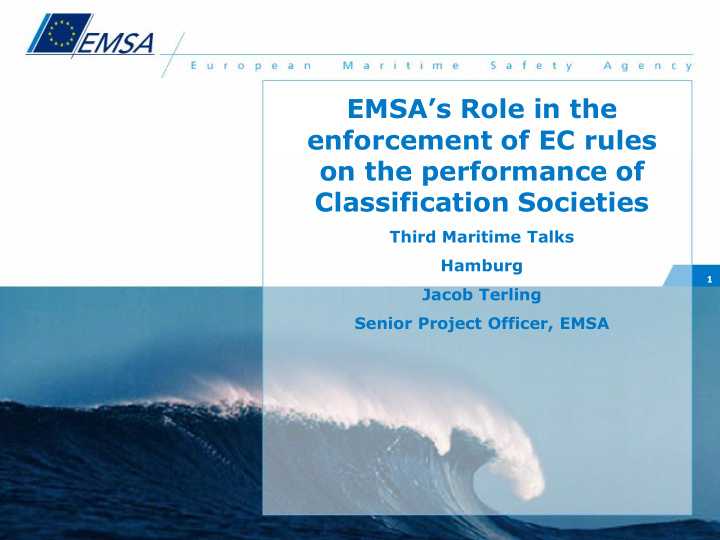



EMSA’s Role in the enforcement of EC rules on the performance of Classification Societies Third Maritime Talks Hamburg 1 Jacob Terling Senior Project Officer, EMSA
Presentation • Short about EMSA • Directive on classification societies 94/57/EC, as amended – Key provisions 2 – Technical Annex • EMSA’s role in the enforcement of EC rules on the performance of Classification Societies – Assessments – Visits to ships – Performance • The Future
The maritime sector and the EU The Size and Weight of the European Union Maritime sector: • 25 Member States, all with a maritime interest, all members of IMO 3 • About one third of global shipping has an EU port as origin or destination • 23 % of the world tonnage is registered in and flying the flag of an EU Member State • 31 % of the world tonnage is controlled by EU interests
EMSA’s Stakeholders and composition of the Administrative Board • The European Commission, 4 members • The 25 EU Member States, 25 members 4 • Norway and Iceland, 2 members without voting right • Romania and Bulgaria, 2 members without voting right • Maritime industries, 4 members without voting rights
EMSA’s main tasks Within the fields of maritime safety, pollution prevention from ships and ship security, EMSA has the following main tasks: • To provide technical advice to the Commission and MS with a view to ensuring the proper implementation of 5 EU maritime legislation • To foster technical cooperation between Member States and disseminate best practice • To provide operational capabilities, in particular to top up Member State’s capabilities for oil pollution response
EMSA organisation chart Executive Director Willem de Ruiter Bureau of the Information and Executive Director Communication Unit C: Safety Unit E: Technical 6 Unit B: Operations Unit D: Implementation Unit F: Oil Pollution Unit A: Resources Assessments & Co-operation and Support EU Maritime Legislation Response Tom Van Hees Inspections Development Marc Jeuniaux Panagiotis Petropoulos Leendert Bal f.f. Ib Matthiesen Emilio Martin Bauza B.1 Information & D.1 Ship Safety F.1 General Policy A.1 Human C.1 Assessments E.1 Ship Communication Standards and and external Resources of Classification Reporting Technologies Marine Equipment affairs Societies B.2 Legal Affairs, F.2 Research, A.2 Budget and C.2 Training of D.2 Port State E.2 Accident Procurement and Evaluation and Financial Affairs Seafarers Control Investigation Facilities Innovation D.3 Environment E.3 Co-operation C.3 Maritime F.3 Operational protection, port with Member Security Activities reception facilities States E.4 Liability and F.4 Monitoring and Compensation Surveillance
Growth of the Agency Number of staff 90 80 70 7 60 50 40 30 20 10 0 Mar- Jun- Sep- Dec- Mar- Jun- Sep- Dec- Mar- 03 03 03 03 04 04 04 04 05
Safety Assessments, Inspections EMSA Assessments are an important tool for ensuring proper implementation of EU maritime legislation and include: • Assessments of EU recognised classification societies • Visits to Member States administrations to verify 8 implementation of PSC • Assessments of maritime education and training systems in third countries • Assistance to the Commission on security inspections
Directive 94/57/EC, as amended • Key provisions – Article 4 – Recognition 9 – Article 3 – Authorizations – Article 6 – Agreements – Article 11 - Assessment cycle – Article 15 + Technical Annex - part A and B
Directive 94/57, as amended Organisations recognised on the basis of Article 4(1) of Directive 94/57/EC: – American Bureau of Shipping (ABS) – Bureau Veritas (BV) – China Classification Society (CCS) – Det Norske Veritas (DNV) – Germanischer Lloyd (GL) 10 – Korean Register of Shipping (KR) – Lloyd's Register of Shipping (LR) – Nippon Kaiji Kyokai (NK) – Registro Italiano Navale (RINA) – Russian Maritime Register of Shipping (RS) • 2. Organisations recognised on the basis of Article 4(3) of Directive 94/57/EC: – Hellenic Register of Shipping (HRS) (The effects of this recognition are limited to Greece and Cyprus) – Registro Internacional Naval, SA (RINAVE)(The effects of this recognition are limited to Portugal)’.
EMSA’s Role in the enforcement • Assessments - cycle is that RO’s should be done once every two years • EMSA is not only assessing Head Office but include – Regional offices, Plan approval and site offices all over the world 11 • The assessments follow an established methodology in order to maintain a uniform approach towards RO’s • The approach is focusing on two aspects: – Quality System – documentary assessment in relation to all the qualitative criteria in the technical Annex – Implementation of the Quality System – checking shipfiles (irrespective of flag)
EMSA’s role in the enforcement • Visits to ships – Important tool, complement and validation activity for the performance of RO’s – Pilot project started 1 March 2005 12 – Evaluation meeting held 1 March 2006 • Visit to yards and site offices – Where possible assessments also include a visit to new building projects
EMSA’s role in the enforcement • Performance – Analysis and Trends of class related detentions • Paris MoU • USCG 13 • Tokyo MoU • Article 9 - Development of criteria/scheme for measuring the performance of RO’s
PARIS MOU PSC AREA detentions as a % of inspections 10.00% 9.00% 8.00% 7.00% All detentions 14 6.00% Class related detentions (CRD) (all 5.00% CS) Class related detentions(CRD) (12 4.00% EU RO) 3.00% 2.00% 1.00% 0.00% 1999 2000 2001 2002 2003 2004 Source: PMOU annual reports. Elaboration: EMSA
USCG PSC AREA Class related detentions (CRD) as a % of distinct vessel arrivals 0.60% 0.50% 0.40% 15 12 EU RO average 0.30% All CS average 0.20% 0.10% 0.00% 1999 2000 2001 2002 2003 2004
TOKYO MOU PSC AREA Class related detentions(CRD) as % of inspections 3.00% 2.50% 2.00% 16 All CS 1.50% 12 EU RO Average 1.00% 0.50% 0.00% 2003 2004 Source: TMOU annual reports. Elaboration: EMSA
THE FUTURE • Proposal for a revised Directive (COM (2005)587 Final of 23-11-2005) • Enlargement of the European Union 17 • Lisbon
THANK YOU FOR YOUR ATTENTION • Any Questions? • www.emsa.eu.int 18
Recommend
More recommend